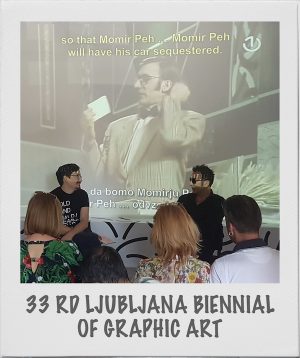We stopped asking ourselves whether truth can set us free a long time ago. In the era of post-truth, fake news and the like, when such metaphysical entities as the Truth seem harder to grasp than ever, we are forced to find solutions for our contemporary aches in the less exalted ground. Plagued by problems direr and darker than ever before in history, and more disillusioned than ever, we turn to our everyday to find fragments of inspiration that could potentially ignite the spark of change. Such is this case with the 33rd Biennial of Ljubljana, entitled Crack up, Crack down, where its curators, the artist collective Slavs and Tatars pose a question: In the era of post-truth, can a joke set us free?
And where better to pose new questions than at a biennial that is determined to reinvent itself. Founded in the depths of the Cold War, its role was one of an intermediary, similar to that of Yugoslavia, between the two antagonist blocks of the era. Established from the initiative of Zoran Kržišnik, then Director of Ljubljana Museum of Modern Art, who pragmatically opted to rely on the logistically untroublesome graphic medium, the Biennial was able to establish itself as the platform where (modernist) East met (modernist) West. Following Yugoslavia’s third way course of foreign policy, better known as the non-aligned movement, the Biennial not only accommodated the unprecedented selection of the Western cannon’s giants in dialogue with the masters of the opposing political block, but also provided a platform for artistic representation of the developing world. This was all in the Biennial’s heyday, the 1960s and 70s, which seemed all but lost with the disintegration of Yugoslavia.
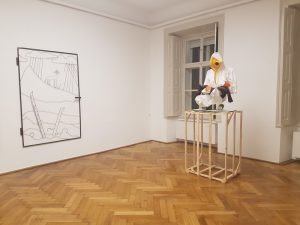
The nonchalant yet scholarly approach of Slavs and Tatars must have struck a chord with the International Centre of Graphic Art, the Biennial’s organizing institution, eager to have its great tradition re-imagined in the context of our present concerns. Slavs and Tatars work both as an artist collective and a research platform, pulling from oblivion and cross-referencing diverse cultural forms and phenomena from the vast geopolitical pool “East of the former Berlin Wall and West of the Great Wall of China known as Eurasia”. And thus Crack Up, Crack Down was born, the 33rd reiteration of the Ljubljana Graphic Biennial. Dealing with satire, a genre that brings together graphic arts and humorous political critique has both a rich history and a vibrant present. One could almost claim that with every repolarization of political views, satire finds new ground and self-awareness. What Slavs and Tatars want to reflect on is the question of whether satire is really all it’s cracked up to be. Pun definitely intended. We know that humour has a political sting, but it is also true that works both ways: remember both political progressives and reactionary moralists of the past used satire to get their messages across. And we need no reminders that as hilarious as anti-Trump memes are, the alt-right is just as at home (if not more) with the critical instruments of satire.
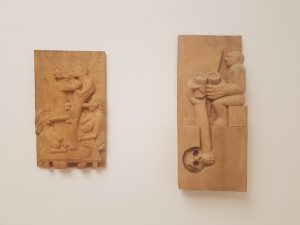
What the Biennial poses as its central question is how does humour really work? Sly, slippery and seditious. There’s plenty to choose from in the ICGA’s baronial mansion and five other venues around the city. Take Georgian artist Giorgi Xaniashvili’s amazing woodcuts: produced from the same blocks of wood used by the artist at his day job, painting Eastern Orthodox icons, the reliefs show salacious love scenes worthy of Kamasutra. Reverence subtly turning to irreverence.
Such is also the case with monumental prints of Xiyadie, where phytomorphic strings of male bodies in the act of lovemaking are unceremoniously inserted in the intricate vegetative patterns of centuries-old craft of paper-cuts. This is a leitmotif we follow throughout the show; the surface carrying both its opposites, being the place of representation and at the same time, without any apparent changes in its logic, destabilizing its own credibility. Lin May Saeed’s moving sculptural odes to the suffering wildlife work with the same strategy: her Styrofoam animal Pieta’ scene both exalts cheap material and indicts its petroleum-based structure. Slavs and Tatars’ points on humour seem to be skin deep, but not in the least less penetrating on that account. Their question on what makes us laugh and what is disturbing about our very own language being used against us.
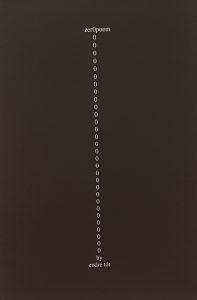
Text-based works of KRIWET, a self-taught Dusseldorf pioneer of media art, are hypnotic circular visual poems that link words together into a whirlpool of infinitely expanding and ever quainter neologisms, challenging the intent of meaning. Infinity is at work again in the work of yet another conceptualist legend, Endre Tot, whose Zero series takes shape of a monumental wall poem at the very entry to the exhibition. Tot’s Ten Questions are standing in for the Ten Commandments, giving us playful combinations of voids, where they were once prescribed certainties.
One could say that Crack up, Crack down is less about taking on the political strongmen of our day and age through satire, and more about the mechanisms of humour in dealing with power, but also in dealing with ourselves. There is a definite existential angst throughout the show that many of the works relate to. Nowhere is it more apparent than in Amanda Ross-Ho’s series of huge emoji-like ideograms of anguished faces. Taken from a pain rating scale, these intricately sown giants mesmerize and perplex, inviting with their textures and familiar shapes, while disturbing with their suffering expressions and anguished titles. Ross-Ho’s work best encapsulates the essence of the show: notwithstanding its physical flatness and popular visuals, its puzzling codes don’t give themselves away easily. Not at all.
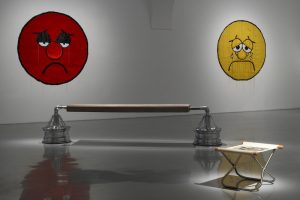
Despite all its stimulating visual splendour, there is a certain impenetrability that pervades the show, which seems to be central to the curators’ very point on the workings of humour. Humour seems to work best when one can’t immediately reach it, when it slides through layers of visual and verbal messages. So to return to the initial question of whether a joke can set us free, the potential answer that the shows seems to allude to is: only when you don’t expect it to.
Apart from several worthy exceptions (i.e. 1980s Sarajevo comedy collective Top lista nadrealista), there are few references to the realpolitik in the show, which implies that the political sting of humour stems from more than politician puns. Humour works in as much as its disrupts our lines of communication and manages to get its message across, whatever that may be. It’s like in Honza Zamojski’s installation The Gathering and The Meeting, a Gulliver-like scene of enigmatic heroism where there is no intent, only free sliding of meanings.
Opaque as such an ending might sound for a review of a show that deals with such a merry thing as humour, don’t be fooled: in order to crack us up, humour must first work through cracks of the seemingly smooth surface of our every day and mess it up. It is here that slips, dreams, deflections and diversions work their charm.
33rd Ljubljana Biennial of Graphic Art
Crack Up, Crack Down
7 July – 29 September 2019
Curated by Slavs and Tatars
Vladimir Vidmar is a curator based in Ljubljana. He is currently running Mala galerija, the official gallery space of the Ljubljana University. Previously, he was the Artistic Director of Škuc Gallery and curated the shows of Tadej Pogačar, Becky Beasley, Nikita Kadan, Nika Špan, Mladen Stropnik, Katalin Ladik, among others. Vidmar also (co-)curated a number of group show, including Crises and New Beginnings: Art in Slovenia 2005-2015 at the Museum of Contemporary Art Metelkova in Ljubljana.


